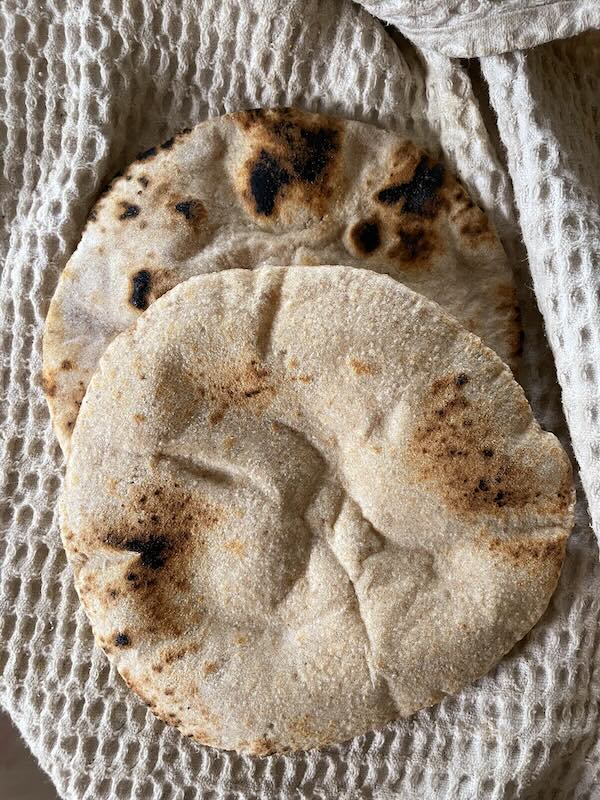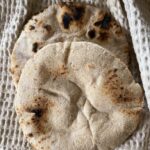A healthy pita bread variation made from one hundred percent whole spelt and sourdough starter. Whole spelt pita bread is hearty, a perfect accompaniment to meals.

Perfect pita bread is easy to achieve at home, even using whole grains. I feel that baked goods using whole grains sometimes have a reputation for somehow being more healthy and less tasty than their white, processed counterparts. That is wrong and bread prejudice! The true foodie knows that whole grains are not only healthy but more importantly, tasty!
Variety is the spice of life. Why bake with only one kind of flour (bread wheat) when there are so many more types of grains and flours at your disposal, each one offering its own unique taste and texture?
Baking with whole grains imparts flavor and depth. For instance, using rye flour in sourdough changes the taste profile of the bread completely. Rye bread is much more sour, sweet, and molasses-like than wheat bread. (Did you know that rye and barley are also part of the wheat tribe Triticeae?)
Even within the wheat genus, there is a great deal of variety. Major species include the common wheat (aka bread wheat), spelt, durum wheat, emmer, kamut, and einkorn. All of these wheat varieties can be found at the grocery store and work well in recipes calling for wheat flour.
What is spelt flour
Aside from being one of my favorite whole grain flours to bake with, spelt is also considered an ancient grain. Specifically, this means that spelt is a species of wheat that was cultivated before the Green Revolution, which was associated with selective breeding and genetic modification technologies to better agricultural yield.
I do not consider spelt better than generic modern wheat (that would be like comparing plantains to bananas). Each has their own characteristics and attributes. Visually, whole spelt flour has a warmer hue than whole wheat flour. Perhaps spelt also has a slightly nuttier taste. Otherwise, spelt and wheat have similar nutritional value and gluten content.
This means that spelt flour behaves very similarly to generic wheat flour when used in baked goods. Spelt is in fact a type of wheat (unlike certain other whole grains like barley or rye, which is only part of the same taxonomic tribe). Overall, spelt is a versatile flour and a breeze to bake with. I like to use spelt in sourdough, pancakes, muffins and other baked goods.
Baker’s percentage
| Weight (grams) | Ingredient | Percent (out of total flour*) |
| 400 | Whole spelt flour | 100 |
| 240 | Water | 60 |
| 4-5 | Salt | 1-1.25 |
| 12 | Oil | 3 |
| 40 | Starter | 10 |
* For ease of use, this calculation of total flour amount does not include the flour that is in the starter.
Suggested baking schedule
- Pita bread is ready in the morning
- 10 pm (or 1-2 hours before bed): make the dough, giving it 2-4 stretch and folds at 20 to 30 minute intervals. Let ferment overnight at room temperature. (Note: my ambient room temperature at nighttime is around 19-20 degrees Celsius. Beware of over-proofing if you live in a warm climate.)
- Next morning, 7 am (or whenever you wake up and are ready to make bread): punch down, divide and preform dough. Roll and cook pita bread.
- Pita bread is ready by dinner
- 9 or 10 am: make the dough, giving it 2-4 stretch and folds at 20 to 30 minute intervals, then bulk ferment at room temperature.
- 4 or 5 pm: punch down, divide, and form the dough. Roll out and cook pita bread.

Baker’s notes
- You will see that sugar is optional in this recipe. You will not be able to taste the sugar in the final bread regardless of whether it is added. Instead, sugar is a tool which helps speed up fermentation.
- Similarly, the amount of salt in this recipe has a small range. Salt can be adjusted to control fermentation speed.
- If you use the overnight schedule, err on the side of more salt (i.e. 5 grams) and omit the sugar to slow fermentation. This longer fermentation period may produce a more sour pita bread.
- If you make pita bread in the span of a day, I recommend including the sugar and decreasing the salt (i.e. 4 grams – or even less, if you prefer a speedier and less sour pita bread).
- This recipe has a higher hydration than a typical pita bread recipe due to being composed of 100% whole spelt flour. The high bran amount in the spelt flour means that more water will be absorbed. For pita bread made with white flour (or only using a portion of whole grain flour), I typically use around 55% hydration.
Pita bread tips
- My preferred method of cooking pita bread is lightly on a pan, then intensely over an open flame. This ensures that pita bread consistently puffs up. I recommend taking a quick look at this post: How to make pita bread puff up, every time, which addresses how to troubleshoot common problems causing pita bread to not puff up properly.
- Be sure to lightly flour when rolling out the dough, dusting off excess flour as you work. Make sure to roll out the pita evenly – there should not be any thin or thick spots. These practices will help prevent tears in the pita bread and ensure even cooking.
- Be gentle when handling the rolled-out pita bread, as a tear in the raw dough will prevent puffing and proper cooking via steam.
100% Whole Spelt Pita Bread
Equipment
- Gas burner
- Rolling Pin
- Flat pan or tawa
Ingredients
- 400 g whole spelt flour
- 240 g water
- 4-5 g salt (roughly 1 tsp)
- 1 tbsp sugar optional
- 12 g oil (1 tsp)
- 40 g active sourdough starter
- additional flour for rolling
Instructions
- Combine all ingredients in a bowl and knead to form a cohesive dough.
- Perform 2-4 stretch and folds at 20-30 minute intervals.
- Bulk ferment for 5-10 hours (adjust depending on room temperature and strength of starter). When ready, the dough should have at least doubled.
- Punch down dough, and divide into 8-10 equal pieces. Form each piece into a round sphere, pinching to make the spheres seamless. Press down into patties.
- Working with one or two rounds of dough at a time, roll out into 3-5mm thick circles, lightly flouring and turning and flipping the dough the entire time.
- Heat up a flat pan or tawa over medium high heat (7-8 out of10). Gently transfer rolled out pita to the pan, cook 30-40 seconds eachside. There should be some minor bubbles and grooves in the flatbread but no major puffing at this point. Turn off the heat.
- Gently move the par-cooked pita bread onto a gas burner. Ignite the flame to high (8-9 out of 10); the pita should puff up almost immediately (within 1 or 2 seconds) and steam profusely. Cook the pita for 20-30 seconds, and then flip and cook 20-30 seconds on the other side, moving the pita around with a pair of metal tongs or chopsticks as needed for even charring. Turn off the flame.
- Transfer the cooked pita to a clean kitchen towel while still warm. Wrapping the pita breads in a kitchen towel will help keep them soft.
- Roll out and cook the remaining rounds of dough one at a time in the same fashion.
Subscribe to my newsletter
(Sporadic) updates on new posts and recipes sent straight to your inbox.

Leave a Reply